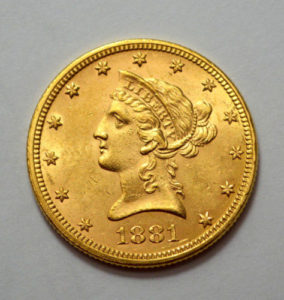$10 Liberty Head Gold Eagle (1838-1907)
The $10 Liberty Head Gold Eagle is reminiscent of a time when the monetary system was based on denominations of the metal value attached to them. As a result, the US followed in line with European practices in governing their monies by which precious metal they were made of. The ‘Eagle’ was a gold coin and was considered a standard denomination of such right up until printing was canceled. The Eagle based measurement of currency actually used a ‘dollar’ value, and thus the Liberty Head Gold Eagle became the unit of measurement for ten dollars. Other Eagle coins include the gold quarter-eagle, the gold half-eagle, the eagle, and the double-eagle coins.
These coins have a unique design when sourced from the first two years of printing. Liberty’s shoulder line points between the twelfth and thirteenth stars. Late in 1939 the artist responsible for the coins development – Christian Gobrecht (an engraver by trade) was dissatisfied with the angles on the coin. He re-positioned his work so that Liberty was square in the middle and centered it over the date for subsequent printings. Thus it became that the most highly sought after $10 Liberty Head Gold Eagle’s originate from either 1838 or 1839.
There is one other marked difference in the coins. Some of them contain a motto, and some do not. The Eagle was the largest of its kind printed by the US Mint under the new metal inclusion guidelines of 1792, and began its life when the Mint still used the 15:1 ratio of precious metals in their coins. After a 34 year lull in the ability to produce such hefty weighted coins, 1838 saw the California gold rush and other circumstances that led to its reintroduction. The American Civil War did very little to help this coin spread to the regular Joe’s of society and, because of its high gold ratio, it was frequently melted down. This was noted and became a problem until the gold ratio in the coins was lowered, taking a little of the value away from the Liberty Head once again.
Around the 1860’s the populace started to demand that something representative of their great faith should appear on their coinage, and the Mint started to produce a variety of motto’s which would then be printed on the coins. On March 3rd of 1865 the Coinage Act meant that, from then on, all coins would be embedded with the fortune ‘In God we Trust’ – and it has remained since to this day. As a result there are two versions of the $10 Liberty Head Gold Eagle – one with no motto, and one with the motto. There are also several variations of the artistry of this coin, with the most expensively sought after featuring the coronet on the Eagle and no motto, and were Minted in the (back then very new) Philadelphia Mint. After the motto was introduced the popularity of this coin sadly faded among collectors and spenders alike until they eventually replaced the Eagle all together.
